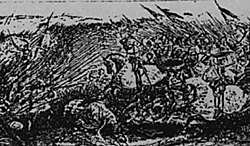
In the first week of September, the English army under the command of Earl Surrey of Berwick with Sir Hugh Cressingham as his second, had reached Stirling. William Wallace and Andrew Murray had assembled the rebellious Scottish army in a strong position perhaps a mile north east of the wooden bridge on Abbey Craig's lower slope facing south. The army's left was protected by the River Forth which looped at the place, and then covered the causeway that ran to Stirling bridge. The causeway was flanked on either side by wet but passable meadows. The Scots numbered between 6-9,000 established by their battle frontage.
The English Army outnumbered the Scots, (perhaps by 5,000 men), that during the several day parley for terms to end the rebellion, Surrey was so unimpressed by the number of Scots he faced, that he followed Sir Hugh's advice and sent one contingent home to save money. The fact that he reduced his army's strength, would come back later to haunt him.
By September 11, 1297, it was evident that no solution could be reached by words, so the English prepared to advance to cross the bridge and on the Scottish position. The bridge was so narrow, we are told, that only 2 knights could ride abreast. However, Sir Richard Lundy scouting two miles upstream, found a ford at where the Forth meets the Tieth River, a crossing where up to 60 men could move abreast When he returned to inform his leaders of his strategic discovery, he found that Surrey was asleep, and Cressingham dismissed him and his plan, saying a flanking move would be waste of time. History certainly would have been different, if the English could have flanked the Scots out of their position.
 As noon approached, the English started to
cross Stirling Bridge. History does not
record Wallace and Murray's impressions
of this supreme folly, but it very apparent
that they were unaware of the ford, and
had a force appeared to turn their flank, a
much different battle would have resulted.
But the English did not turn the Scots'
flank, and the force, waiting until
half of the English army was separated by
the Forth, charged.
As noon approached, the English started to
cross Stirling Bridge. History does not
record Wallace and Murray's impressions
of this supreme folly, but it very apparent
that they were unaware of the ford, and
had a force appeared to turn their flank, a
much different battle would have resulted.
But the English did not turn the Scots'
flank, and the force, waiting until
half of the English army was separated by
the Forth, charged.
In the resulting melee, Sir Hugh, leading the vanguard was cut down, and the English were unable to reinforce the trapped division. The bridge was destroyed, history does not relate by who, and out of the pinned mass, only the lightly armored Welsh bowmen could swim back across the river. The English lost possibly half their army, 5,000 men, the Scots maybe, 2,000. However, Scots also lost one their greatest leaders, Andrew Murray, who was killed, or died shortly afterward from his wounds, having William "Braveheart" Wallace knighted and become the sole guardian of the Scottish Kingdom.
Behind the Battlescenes of Braveheart (movie)
Back to Saga #54 Table of Contents
© Copyright 1996 by Terry Gore
This article appears in MagWeb (Magazine Web), available on the Internet World Wide Web at http://www.magweb.com
